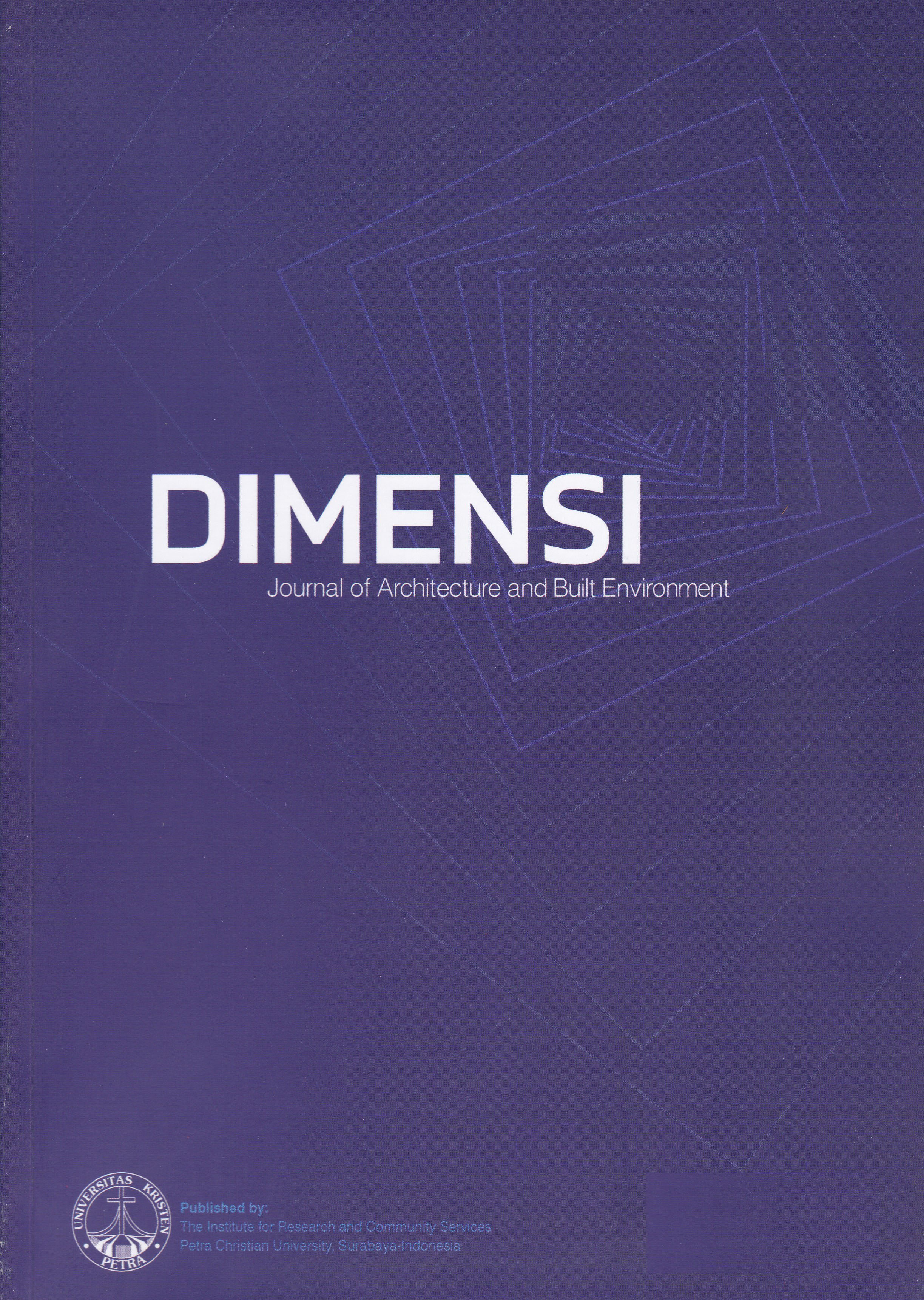PEDESTRIAN BEHAVIOR FOR DEVELOPING STRATEGY IN TOURISM AREA; AGENT-BASED SIMULATION
DOI:
https://doi.org/10.9744/dimensi.48.1.65-74Keywords:
Pedestrian, agent-based modelling, design strategy, tourismAbstract
Agent-based modelling is an approach to develop a design strategy in socio-related studies to understand pedestrian behavior by using simulation through validation using field observation. This study area has a historic city so that having several potential advantages as destination tourists and also having urban issues. Some facilities disseminate prosperous for domestic tourist destinations, transportation hubs (land and water-based transport), and public facilities. The purpose is to develop a design strategy of pedestrian behavior in urban space to be procedure based on computational modelling. By merging the result, it helps designers to depict pedestrian movement flow, permeability, and connectivity patterns, which represent the presumptions of the origins or source of movement, destinations, generators, and attractors of movement. This simulation examines and valuates spatial behavior models allowing to route preferences of each pedestrian in order to be used in the strategy of design process for architect, urban planner, or other designer stakeholders. The result will imply a walkable pedestrian-way design, where this approach of a pedestrian experience might be an effective tool in city planning.
Downloads
References
Alexander, C., Ishikawa, S., & Silverstein, M. (1977). A Pattern Language; Towns, Building, Construction. Oxford University Press.
Al-Mamun, M. M., Begum, A. A., & Mowla, Q. A. (2018, June). Walkability for Urban Sustainability: Study of Pedestrian Traffic in Chittagong. Jahangirnagar University Plannind Review, 16, 87-102.
Aschwanden, G. D. P. A. (2012). Agent-Based Social Pedestrian Simulation for the Validation of Urban Planning Recommendations. SIGraDi 2012- Proceedings of the 16th Iberoamerican Congress of Digital Graphics - Brasil - Fortaleza 13-16 November 2012.
Asriana, N., & Indraprastha, A. (2016). Making Sense of Agent-Based Simulation; Developing Design Strategy fo Pedestrian-Centric Urban Space. The 21st International Conference of the Association for Computer-Aided Architectural Design Research in Asia CAADRIA, 343-352. Melbourne, Australia.
Batty, M. (2003). Agent-Based Pedestrian Modelling (Centre for Advanced Spatial Analysis).
Batty, M. (2005). Cities and Complexity.
Beavon, D. J. K., Brantingham, P. L., & Branting¬ham, P. J. (1994). The influence of street net¬works on the patterning of property offenses. Crime Prevention Studies, 2(2), 115–148. http://www.popcenter.org/library/crimeprevention/volume_02/06beavon.pdf
Bonabeau, E. (2002). Agent-based Modeling; Methods and Techniques for Simulating Human Systems. Proceeding of The National Academy of Science, 99(3), 7280-7287.
Chen, L. (2012). Agent-based modelling in urban and architectural research: A brief literature review. Frontiers of Architectural Research, 1(2), 166–177. https://doi.org/10.1016/j.foar.2012.03.003
Crooks, A., Croitoru, A., Lu, X., Wise, S., Irvine, J. M., & Stefanidis, A. (2015). Walk This Way: Improving Pedestrian Agent-Based Models Through Activity Analysis. ISPRS International Journal of Geo-Information, 1627–1656. https://doi.org/10.3390/ijgi4031627
Filomena, G., & Verstegen, J. (2018). Mental Representation of Space in Agent-Based Models for Pedestrian Movement in Urban Environment: A Conceptual Model. Geospatial Technologies for All: Short Papers, Posters and Posters Abstract of the 21st AGILE Conference on Geographic Information Science.
Gilbert, N., & Terna, P. (2000). How to Build and Use Agent-Based Models in Social Science. Mind and Society, 1(1), 57-72.
Indraprastha, A., & Shinozaki, M. (2009). New Framework of Behavioral-Based Simulation for Spatial Design Assessment. Proceeding of The 11th International Conference on Computers in Urban Planning and Urban Management (CUPUM). Hongkong: University of Hongkong.
Kitazawa, K., & Batty, M. (2004). Pedestrian Behaviour Modelling; An Application to Retail Movements using a Genetic Algorithm. Development in Design & Decision Support Systems in Architecture and Urban Planning, 111-126. Eindhoven: Eindhoven University of Technology.
Klugl, F., & Bazzan, A. L. (2012). Agent-Based Modeling and Simulation. Association for The Advancement of Artificial Intelligence; AI Magaazine, 29-40.
Knura, M. (2019). Agent Based Simulation of Pedestrian Movement in Urban Environment. AGILE.
Kontovourkis, O. (2011). Design of Circulation Diagrams in Macro-scale Level Based on Human Movement Behavior Modelling. Auto¬mation in Construction, 22, 12-23.
Kontovourkis, O. (2011). Pedestrian Modelling as Generative Mechanism for The Design Adap¬tive Built Environment. eCAADe-Simulation, Visualization, Prediction and Evaluation, 850-858.
Leslie, E., Coffee, N., Frank, L., Owen, N., Bauman, A., & Hugo, G. (2007). Walkability of local communities: Using geographic information systems to objectively assess relevant environ¬mental attributes. Health and Place, 13(1), 111–122. https://doi.org/10.1016/j.healthplace.2005. 11.001
Lynch, K. (1960). The Image of The City. Cambridge, London, England: The Massachusetts Institute of Technology Press.
Penn, A., & Turner, A. (2001). Space Syntax based Agent Simulation. 1st International Conference on Pedestrian and Evacuation Dynamics, p.7. Germany: University of Duisburg.
Ronald, N., Sterling, L., & Kirley, M. (2007). An agent-based approach to modelling pedestrian behaviour. In Simulation. https://www.research-gate.net/publication/228931870_An_agent-based_approach_to_modelling_pedestrian_behaviour
Sharma, S. B., & Tabak, V. (2008). Rapid Agent Based Simulation of People Flow for Design of Spaces. In Design and Decision Support Systems (DDSS) in Architecture and Urban Planning . Eindhoven, Netherlands: Eindhoven University of Technology.
Yan, W., & Kalay, Y. E. (2006). Geometric, Cognitive, and Behavioral Modeling of Environmental (DCC). Springer.
Downloads
Published
Versions
- 2021-10-26 (2)
- 2021-10-26 (1)
How to Cite
Issue
Section
License
Authors who publish with this journal agree to the following terms:
- Authors retain copyright and grant the journal right of first publication with the work simultaneously licensed under a Creative Commons Attribution License that allows others to share the work with an acknowledgement of the work's authorship and initial publication in this journal.
- Authors are able to enter into separate, additional contractual arrangements for the non-exclusive distribution of the journal's published version of the work (e.g., post it to an institutional repository or publish it in a book), with an acknowledgement of its initial publication in this journal.
- Authors are permitted and encouraged to post their work online (e.g., in institutional repositories or on their website) prior to and during the submission process, as it can lead to productive exchanges, as well as earlier and greater citation of published work (See The Effect of Open Access).


















